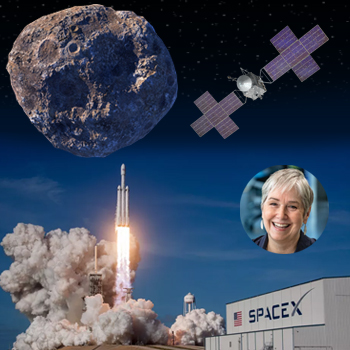Falcon Heavy to Launch Psyche Craft to Metal-Rich Asteroid for August 2029 Encounter |
MONDAY☆ Oct 2 — International Space Station, ~415-km LEO: Expedition 70 seven-member crew working with BioFabrication Facility to print organ-like tissues, Cold Atom Lab module preparation & cleaning, and undergoing VR training for EVA SAFER maneuvering unit. ☆ Oct 2 — Tiangong Space Station, ~390-km LEO: Shenzhou 16 first science lecture from TSS continues to be shared with students, crew preparing for November return to Earth. Highlights… o NewSpace: Sierra Space to bolster Dream Chaser spaceplane development with US$290M investment round with $5.3B valuation; Space Forge, Varda, and Space Tango among companies working to develop in-space manufacturing systems for semiconductors, medicines / biologicals. ☆ Solar System: DOE / UC Berkeley LuSEE-Night team building antenna array ahead of 18-month, lunar night survivable radio astronomy mission to launch NET 2025; OSIRIS-REx Bennu sample being processed by JSC scientists as spacecraft (now dubbed OSIRIS-APEX) on rendezvous trajectory with asteroid Apophis. ☆ Galaxy: Stellar activity of TRAPPIST-1 red dwarf may be interfering with JWST spectroscopy measurements of its planets per University of Montreal study; Astronomers working to reconcile discovery of 1,000+ spiral disk galaxies similar to MWG in early universe with galaxy formation theory; Astronomers at Jiangmen Underground Neutrino Observatory hope to detect signs of pre-supernova stars when operations being NET 2024. o Global: Shenzhou spacecraft chief designer Zhang Chongfeng proposing lunar lava tubes be built out for International Lunar Research Station; I2U2 group (India, Israel, UAE, USA) to develop observation space tool to aid climate change decision-making; Starlink now providing internet access to 2,000,000+ users on 7 continents. ● USA: SLS team working to install propulsion and electrical systems on Artemis 2 core stage following integration of four RS-25 engines; Dave Limp to replace Bob Smith as Blue Origin CEO; NASA seeking industry proposals for ISS de-orbiting after 2030. ● Hawai’i: Asteroid-hunting algorithm HelioLinc3D developed by former IfA astronomer scanning ATLAS datasets for potentially hazardous asteroids like 2022 SF289; 34-foot diameter telescope from Caltech Submillimeter Observatory being prepared for shipment to Chile as $4M site restoration expected to continue into 2024. |
 |
● = Terrestrial and… o = International terrestrial events
☾ = Moon activity ★ = Space and… ☆ = International space / astro events in Hawaii Standard Time unless noted. Add 10 hours to obtain UT (‘Universal Time’). |
Weekly Planet Watch – Evening Planets: Jupiter (ENE), Saturn (SE), Uranus (E), Neptune (SE). Morning Planets: Mercury (E), Venus (E).
74th IAC Gathers World Space Community to Advance Human Spaceflight,
|
o Oct 2-3 — Proximum365, Airbus, Callisto, ESA, Eutelsat, et al, Toulouse, France: Toulouse Space Week 2023. ● Oct 2-3 — Avon Machining, Warner, Lockheed Martin, Atlas Space Operations, Air Force Research Laboratory, Detroit MI: North American Space Summit (NASS); Postponed to Feb 5-6, 2024. o Oct 2-6 — International Astronautical Federation, Azercosmos, IAA, IISL, SGAC, Chinese Society of Astronautics, Baku, Azerbaijan: 74th International Astronautical Congress: Global Challenges and Opportunities: Give Space a Chance; multidisciplinary congress that covers all space sectors and topics. o Oct 2-6 — International Astronomical Union, Instituto de Astrofísica de Canarias, La Palma, Canary Islands, Spain: IAU Symposium 385: Astronomy and Satellite Constellations: Pathways Forward. ☾ Oct 2 — Moon: 2.78° NNW of Uranus, 06:00; 1.08° SE of Pleiades, 21:00. Ongoing… ☾ Sep 6 – NET Jan/March — Smart Lander for Investigating Moon (SLIM), Lunar Landing Trajectory: SLIM Moon mission 4-6 month trajectory to soft land east of Shioli crater (13.2°S, 25.2°E) on Moon near side equatorial region. ☆ Sep 6 – NET Mar — X-Ray Imaging and Spectroscopy Mission (XRISM), ~550-km LEO: XRISM undergoing 6 month check out testing phase before start of science operations to study galactic plasma. ★ NET Q4 — ULA, Launch Vulcan Centaur / Astrobotic Peregrine Lander, SLC-41, Cape Canaveral SFS FL: Astrobotic Peregrine lander to attempt to touchdown near Gruithuisen Domes, with 14 NASA payloads for Artemis Program, CMU Iris Lunar Rover, total 90 kgs of customer payloads from commercial companies and international space agencies, institutions. ☆ NET Oct 1 — ISRO, Launch GSLV L40 / Gaganyaan Test Vehicle Demonstration 1, Satish Dhawan Space Center, Sriharikota, India: Gaganyaan uncrewed capsule to be launched to 11 km for high altitude abort test; capsule should reach 15-16 km testing separation from the rocket, trajectory and parachute deployment. ● Oct 1-6 — American Astronomical Society Division of Planetary Sciences, European Planetary Science Congress, San Antonio TX: AAS DPS 2023 Meeting and Europlanet Planetary Science Congress 2023. |
TUESDAY
o Oct 3-4 — Universiti Kebangsaan Malaysia (UKM), Universiti Watan Kita, Institut Perubahan Iklim, Penang, Malaysia: 8th International Conference on Space Science and Communication (ICONSPACE 2023): Advanced Space Technology: Accelerating Global Agenda.
☆ Oct 3 — Mars: 2.39° NNE of Spica, 03:00.
☆ Oct 3 — Apollo Asteroid 349507 (2008 QY): Near-Earth Flyby (0.042 AU).
WEDNESDAY
☆ Oct 4 — Arianespace, Launch Vega / THEOS-2 & FORMOSAT-7R/TRITON, Kourou, French Guiana: Arianespace to launch Vega rocket designated VV23 with 12 satellites into aSSO including primary Earth-observing satellite THailand Earth Observation System-2 (THEOS-2) and Taiwanese Space Agency Global Navigation Satellite FORMOSAT-7R/TRITON.
o Oct 4-10 — World Space Week Association, Global: World Space Week 2023; to celebrate international contributions of space science and technology to the betterment of the human condition; Oct 4 is 66th observation of 1st Space mission Sputnik One launched by Soviet Union 1957; Oct 10 is 56th observation of Outer Space Treaty going into effect 1967.
THURSDAY
★ Oct 5 — Virgin Galactic, Launch Galactic 04 / VSS Unity, Spaceport America NM: Launch planned for suborbital flight carrying VG pilots Kelly Latimer and C.J. Sturckow, and passengers Namira Salim, Trevor Beattie, and Ron Rosano.
o Oct 5-7 — ELEVATE Organizing Committee, Monte Carlo, Monaco: 2nd ELEVATE Space Conference, Exhibition and Think Tank 2023; including Astronauts and space industry professionals.
☾ Oct 5 — Moon: 4.0° N of M35 cluster, 07:00.
☆ Oct 5 — Ganymede: Shadow of moon Ganymede to transit Jupiter, 11:46-13:52.
☆ Oct 5 — Amor Asteroid 2023 QC8: Near-Earth Flyby (0.040 AU).
FRIDAY
☾ Oct 6 — Chandrayaan-3, Shiv Shakti Point, Moon: Lunar sunset occurs today at 69.373°S, 32.319°E, where Vikram lander and Pragyan rover landed.
★ Oct 6 — United Launch Alliance, Launch Atlas 5 / Project Kuiper, SLC-41, Cape Canaveral SFS FL: Atlas 501 rocket set to launch first two demonstration satellites for Amazon Project Kuiper constellation.
☾ Oct 6 — Moon: At last quarter, 03:48; 4.8° S of Castor, 19:00.
☆ Oct 6 — Apollo Asteroid 2023 RR29: Near-Earth Flyby (0.023 AU).
SATURDAY
● Oct 7 — Mauna Kea Observatories, University of Hawai’i Institute for Astronomy, Kailua-Kona HI: AstroDay West 2023; at Kona Commons, 10:00-15:00 HST.
● Oct 7-8 — NASA, CSA-ASC, ISRO, AEB, JAXA, ASI, et al, Online: International Space Apps Challenge 2023.
● Oct 7-8 — NASA, Southwest Research Institute, San Antonio TX: Juno Open Team Meeting Workshop – Galilean Satellite and Radiation Environment.
☾ Oct 7 — Moon: 1.43° S of Pollux, 01:00.
☆ Oct 7 — Apollo Asteroid 2022 TD: Near-Earth Flyby (0.022 AU).
SUNDAY
★ Oct 8 — Marianist Center of Hawaii, Chaminade University-St. Louis School, Mystical Rose Oratory, Honolulu HI: God’s Mechanics: How Scientists and Engineers Make Sense of Religion; Vatican Observatory Director Guy Consolmagno to deliver lecture on science and religion, 16:00.
☆ Oct 8 — Draconids Meteor Shower Peak: Appearing to radiate from constellation Draco, Draconids offer slow moving (20 km/s) meteors which are faint and fragment easily, about 10-20 per hour; peak 14:00.
☾ Oct 8 — Moon: 1.43° S of Pollux, 06:00.
☆ Oct 8 — Apollo Asteroid 2018 ER1: Near-Earth Flyby (0.032 AU).

